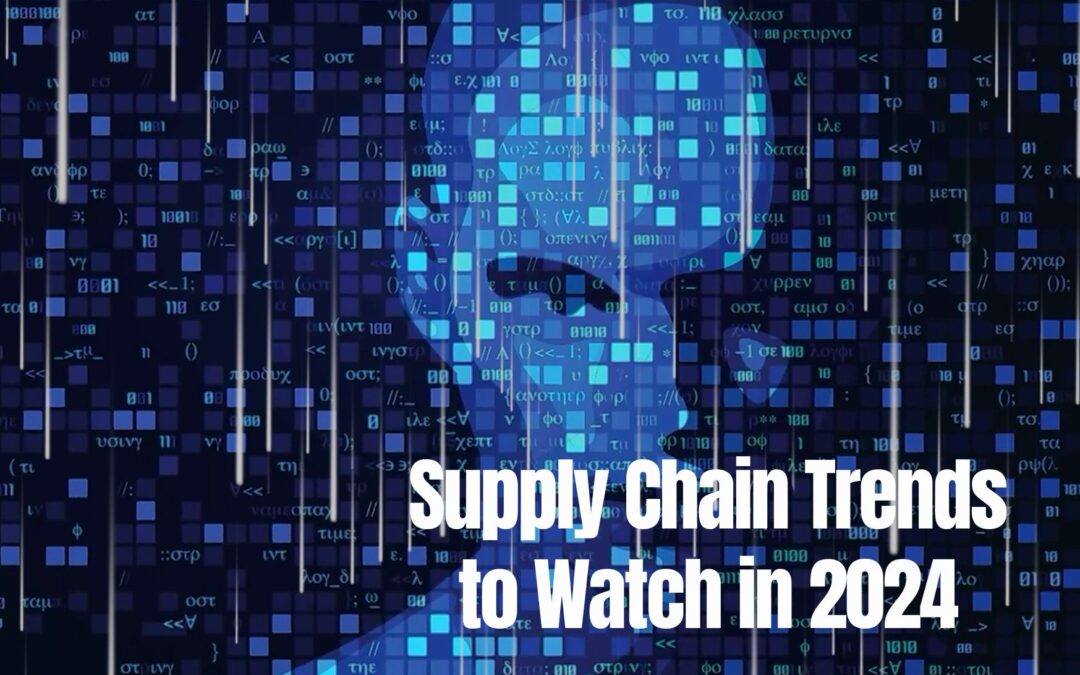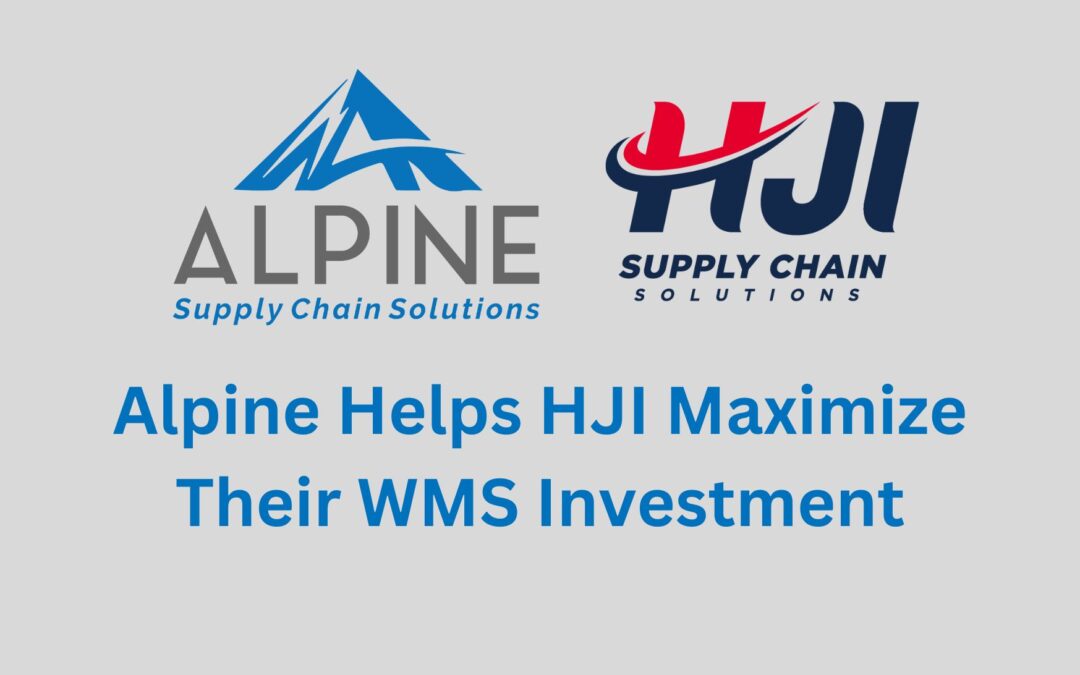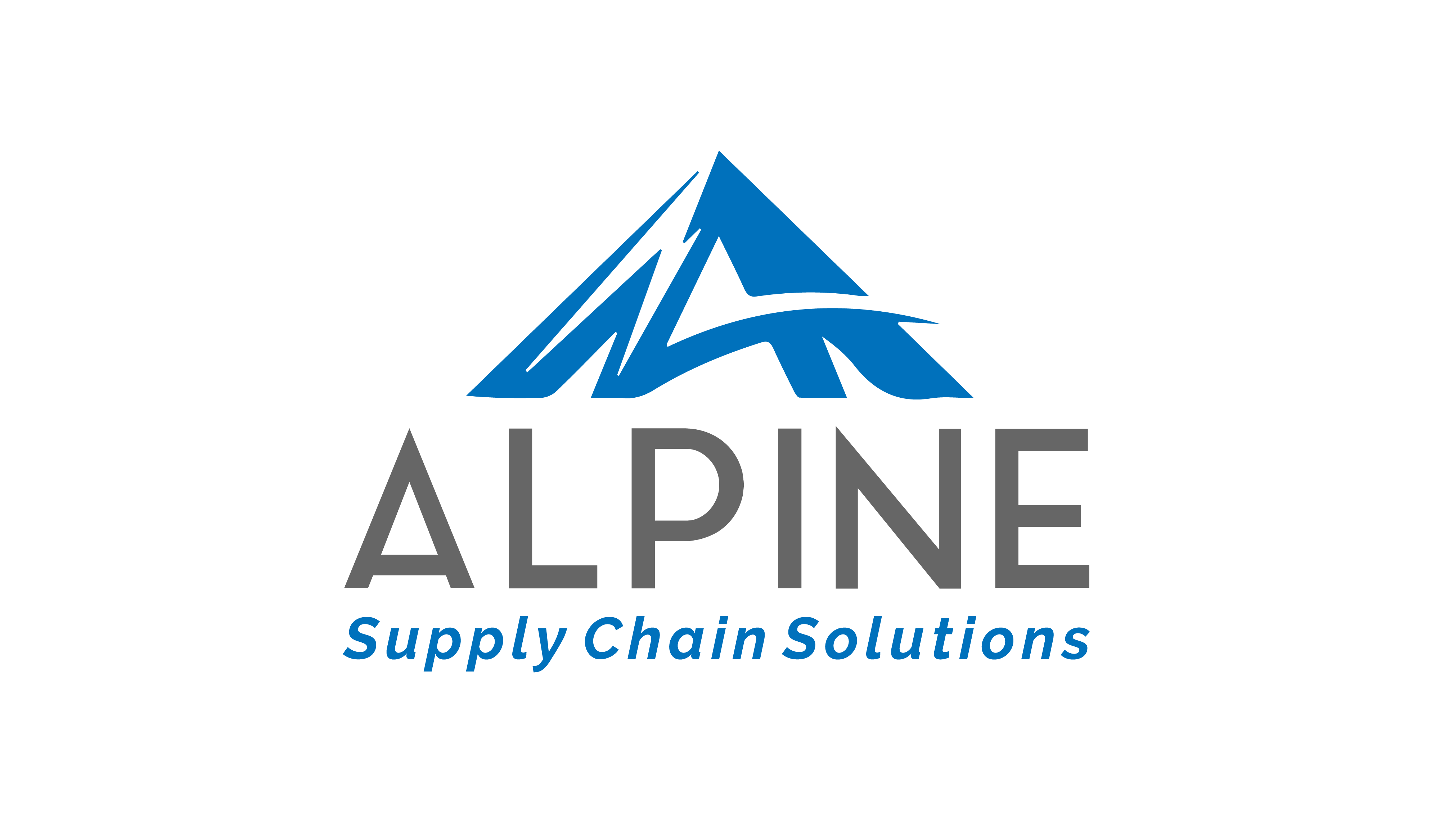
by Noelle Abarelli | Feb 6, 2024 | Blog
Supply chains have had quite a tumultuous time these last four years. From pandemic woes to geopolitical difficulties, the status quo has been put into question again and again. And while the pandemic introduced complications and delays, that time period also forced innovation. Remote capabilities were expanded, the practice of diversifying supply chains became a necessity, and technologies to supplement the supply chain were more widely implemented. And with that came the expanding growth and adoption of generative artificial intelligence (AI).
As 2024 forges ahead, supply chain leaders are taking stock of what rises to the top as key priorities for the year, like resilience and optionality, the safe use of AI, cybersecurity, and how to prepare for potential shortages. Let’s review.
Resilience and Optionality
Companies are prioritizing building resilient supply chains by diversifying sources and locations. The need to do this became abundantly clear during the pandemic when a variety of industries faced material shortages and delays. Northern Tool, for example, is diversifying its sourcing, no longer relying on a single point of origin, securing warehouse capacity in other parts of the country. Having multiple sources gives companies the upperhand in locating backups when needed; flexibility in supply chain management is critical to fostering resilience.
Northern Tool also changed how they handle e-commerce orders. In the past, all online orders originated from a single warehouse, and only 17% of them were being fulfilled the day the order was received. By changing their hours of operation, hiring more employees, and updating job descriptions so employees could do more, as much as 99% of their orders can now be fulfilled on the day they are received.
Of course, resiliency does come at a cost. Having partnerships and agreements with multiple vendors may incur fees, a cost that may be worth taking if it safeguards your supply chain against the unknown. Meeting with multiple vendors and negotiating options that are beneficial for both parties is an excellent way to implement resilience strategies that will last for the long haul.
The AI Advantage
The adoption of technology can help too. A global survey of supply chain professionals across industries in 55 countries found that investing in the latest technologies such as cloud computing, AI, and IoT solutions is more than a tactical necessity. It’s a critical component of enabling business growth and fostering agile supply chain operations.
The aforementioned survey found that 76% of companies believe artificial intelligence will be an important part of their supply chain in the next three years. AI can help supply chains by predicting demand, optimizing routes, and automating mundane tasks. Supply chain leaders believe AI will be able to assist companies react to consumer demand more quickly, eventually fostering a self-driving supply chain with real-time adjustments. Some companies are already using AI and machine learning capabilities to predict individual shopping carts using algorithms, and the more data is collected, the more accurate that capability will become.
The main trend to watch out for in terms of technology is collaborative AI, or leveraging AI as a tool to support human expertise. AI will serve as a worthy partner in a variety of settings, including product development, market research, and quality control. With extensive data, and a deeper understanding of consumer needs and preferences, AI will be able to assist companies in developing products that are tailored to meet the needs and expectations of their target market. AI can help process vast amounts of data, giving companies deeper insights into customer preferences, demands, and emerging and waning trends.
AI is far from perfect, and its benefits are reliant on the fact that it is always learning, always improving. At the moment, it isn’t adept at handling more nuanced aspects like consumer preferences, but leaders predict it’s only a matter of time. Of course, with increased use of technology and the interconnectivity of it all, cybersecurity becomes increasingly more vital.
Security in the Digital Age:
More and more companies are becoming connected digitally, including smaller, less equipped companies. Increased digitization in supply chains exposes companies to new vulnerabilities. Supply chain businesses are not immune to cyber attacks, which is why risk assessments and cybersecurity standards are a must.
Every company will have a different set of cybersecurity standards, but some that are essential, regardless of size or industry are:
- Restricting system and data access to authorized individuals
- Use data encryption
- Implement network security measures
- Provide security training
- Implement an incident response plan
- Designate disaster recovery processes
- Comply with industry-specific security standards
- Practice continuous monitoring
- Develop an audit program to enforce the supply chain cybersecurity plan
Keeping companies safe requires vigilance and collaboration. Clear cybersecurity standards, regular third-party assessments, and continuous data protection are vital. Companies can take a myriad of steps to protect against cyber attacks, but there is no guarantee of safety.
Shortages are still possible
We may be in a period of inventory excess, but that can change at any time. From pharmaceuticals and food to battery minerals and climate-driven disruptions, there are many potential challenges ahead, bolstering the argument for implementing strategies that enable resilience now, so we’re not caught in the fray. Leaders are tracking three key problem areas.
- Pharmaceuticals and Medical Supplies: Ongoing shortages of crucial medicines and long lead times make finding alternative suppliers challenging. This highlights a need for early risk assessment and diversification of sources.
- Food: With concerns about the continued conflict in the Middle East, climate disasters, and lasting impacts of the Ukraine war, building strategic partnerships and exploring local sourcing can mitigate risks.
- Battery Minerals: Surging demand for electric vehicles and clean technologies clashes with geographically concentrated mining, raising supply concerns. Investing in domestic supply chains and long-term contracts can help diminish the impact.
As we step into 2024, the future of supply chains lies in a delicate balance between human expertise and technological prowess. With collaboration, innovation, and a proactive approach, we can foster a more efficient, resilient, and sustainable network for generations to come. As supply chain experts, we have what it takes to ensure you get the most out of your supply chain. If you’re looking for ways to best navigate your supply chain in 2024, look no further. Reach out to find out how we can create an optimal solution that delivers maximum value.

by Noelle Abarelli | Dec 19, 2023 | Blog
Over the past decade, many businesses prioritized the rise of e-commerce without considering the underlying supply chain. While businesses implemented an “all e-commerce all the time” approach, they ignored the importance of addressing the supply chain, leading to limited innovation and stunted growth. Now, to right that wrong, boardroom conversations are returning to supply chain solutions, prioritizing time-to-value, flexibility, and end-to-end accountability. The goal? Building an agile supply chain for the e-commerce age.
Körber Supply Chain published a helpful e-book for the upcoming year, Supply Chain Imperatives: 2024 and Beyond with tips on how to future-proof supply chains. They spoke to partners, thought leaders, and subject matter experts about the value of configuring your supply chain to match your business strategy for years to come. The book is divided into five helpful sections. Below you will find quick summaries of what the book has to offer, but we recommend downloading a copy of it now. It contains far more details that are sure to serve as a useful guide in the coming years.
Section 1: Foundational | Structural | Continuous
Stratagem makes the case for microservices in supply chains. Microservices is a software architecture where large applications are broken down into smaller, independent services that work together through APIs. They are ideal due to its agility, scalability, and resilience, which enables businesses to thrive in the face of growing consumer expectations and constant disruption.
Tsol highlighted nearshoring, which to the US and Canadian market, refers to work performed outside their borders but within a region incorporated by Mexico, Central America, and the Caribbean. It helps facilitate logistics, enables cost savings, and improves skilled labor access, helping to mitigate supply chain uncertainties.
Publicis Sapient dove into supply chain sustainability. Consumers are increasingly prioritizing sustainability, from sourcing to packaging and delivery. Organizations that fail to embrace this shift risk losing market share and damaging their reputation. To succeed in this new landscape, they must build a sustainable supply chain that meets the needs of today’s conscious consumers and secures their long-term success.
Section 2: Commerce and Order Lifecycle
Pivotree, a leader in frictionless commerce, stressed the increasing importance of seamless ordering and fulfillment in today’s competitive market. It recommends using an Order Management System (OMS) to enhance order processing and improve customer satisfaction, with real-time data on inventory, orders, and fulfillment; and a Warehouse Management System (WMS) to reduce space needs, enable error-free order processing, and real-time tracking and automated processes.
Experts over at Perificient argue that personalization reigns supreme and that a seamless omnichannel experience is the new gold standard. They believe the future is driven by AI, that it is transforming e-commerce into a holistic and immersive experience, with AI-powered customer support and intelligent solutions to manage inventory levels.
Körber explains how adopting the “on time in full” key performance indicator allows businesses to measure a company’s ability to deliver on their promise while capturing the highest gross margin on their inventory investment.
Section 3: Warehouse operations and design
As Körber’s 2023 Breakthrough Partner of the Year, Alpine Supply Chain Solutions was invited to contribute to the publication, and our Senior Managing Director, Greg Utter, provided his insight into the evolution of warehouse control systems and how they play a pivotal role in optimizing distribution centers and warehouses. As supply chain complexities continue to grow, the synergy between WCS, automation, and WMS solutions remains essential for maintaining competitiveness and efficiency, while fostering an agile supply chain.
EnVista shared best practices for warehouse management, covering omnichannel fulfillment strategies, cloud-based WMS solutions, automation & robotics, and AI and machine learning. By embracing these WMS best practices, businesses can block new levels of efficiency.
Thought leaders at Extolla focused on the significance of distribution center (DC) design and the consequences of neglecting it. They explain how a poor DC design with ineffective storage can lead to operational inefficiencies, inaccurate inventory management, safety hazards, and reduced employee well-being.
Section 4: Fulfillment
Easypost lists carrier diversification as a key step to take to avoid capacity crunches and spiraling costs. They uncover countless tips that equip businesses with the tools they need to maneuver the intricacies of a multi-carrier strategy.
Folks at Red Shift believe fulfillment optimization can help protect profit margins. Inventory management, order orchestration, physical fulfillment, shipping optimization, and customer communication are some of the main strategies operations can employ to improve fulfillment as a whole.
Section 5: Labor and Robotics
Nowadays it’s almost impossible to talk about labor without the mention of robotics. Experts at Bricz believe that labor challenges will continue, which means more robotics solutions should be expected. They predict fewer new vendors entering the robotics space with some established vendors consolidating and the automation space growing as both vendors and customers work to solidify new automation value drivers.
Vaibe believes gamification is the answer to addressing ongoing problems of low engagement and turnover. They stress that gamification is the answer to unlocking the power of employee engagement by reducing absenteeism and turnover rates and improving quality control and productivity.
The e-commerce revolution is here to stay, but its success hinges on an adaptable and agile supply chain. While the promise of instant gratification and global reach is undeniable, it’s important to remember that behind every purchase lies a complex, interconnected web. A successful supply chain isn’t just about keeping up; it’s about taking the lead. Körber’s e-book provides tons of actionable insights to equip your business for the exciting years ahead. Download a copy of it today, and for more details on how to implement supply chain solutions that offer a measurable ROI, simply give us a call, we’re here to help.

by Noelle Abarelli | Sep 14, 2022 | Blog, Warehouse Management System
If there’s one thing we know for certain it’s that when we make a considerable investment in technology, we want to see that investment pay off. We want to know that our time, effort, money, and resources were not wasted. So, when HJI Supply Chain Solutions implemented the Körber WMS, they expected to maximize space, improve efficiencies and increase productivity across their entire business. Unfortunately, without a dedicated resource to grow and support application use, the Körber implementation stalled and failed to yield the desired results. In fact, HJI had an underutilized WMS and was considering starting all over again with an entirely new WMS system.
Before completely scrapping what had already been done, HJI reached out to Alpine for insight. As Körber WMS experts, Alpine had the skills to determine a solution for HJI to get back on track. Alpine re-engaged with Körber and led the execution of client-side responsibilities, giving HJI the time to focus on running their operations without interruption. Alpine took on:
- Developing a full acceptance test plan to assist with the execution and documentation of the user acceptance testing process.
- Documenting work instructions and standard operating procedures.
- Serving as the communication conduit between Körber WMS, ERP providers, and the HJI team.
And much more! In the end, The implementation was a success and, in the process, HJI was able to broaden and deepen its solution knowledge base. HJI has since successfully rolled the Körber solution out to a larger facility in Louisville and two additional facilities in Memphis. They are securely under Körber’s support wing and are now working to fully link all clients and all warehouses on the application.
This August, Alpine Supply Chain Solutions was named to this year’s SupplyChainBrain list of 100 Great Supply Chain Partners. As part of their coverage, SupplyChainBrain documented the entire project between HJI and Alpine, you can view that article here.
And, If you’re struggling with a WMS implementation, don’t give up! Engage with experts who can provide a second opinion to ensure you’re not missing out on opportunities to make use of the investment you’ve made. If you’d like help with your project, don’t hesitate to give us a ring.

by Alpine Supply Chain | Jan 28, 2020 | HR Solutions
Alpine is growing again! We are proud to welcome Brenda Stoltz as the leader of our new
Human Resource Solutions Practice. With her operational leadership background and recent experience heading up HR at Target Distribution, Brenda brings real-world experience to the talent needs of warehouses. Ensuring high-end compliance and execution of work responsibilities, she excels in the areas of staffing, employee relations, performance management, payroll/compliance, training and development, organizational restructuring, workforce planning, and change management.
Brenda Stoltz is a Human Resources Leader and an experienced Operations Manager instilled with the practical knowledge of strategic leadership and management. She holds a strong sense of business objectives and strives to develop a positive culture that promotes constructive growth. As a dynamic leader with robust interpersonal skills, she holds experience in leading highly proficient teams comprising of HR Specialists, HR Business Partners, and operations managers. She aims to develop a healthy workspace environment that nurtures new talent and helps operational partners meet their goals.
Brenda’s greatest source of inspiration comes from witnessing the growth and development of team members & operations partners. She admires working with others and helping them identify, analyze, and solve complex business issues through strategic leadership and teamwork. Besides this, she is an outdoor enthusiast who loves spending time in the company of her husband and two wonderful toddler boys.






